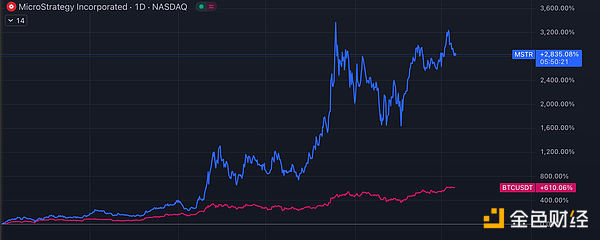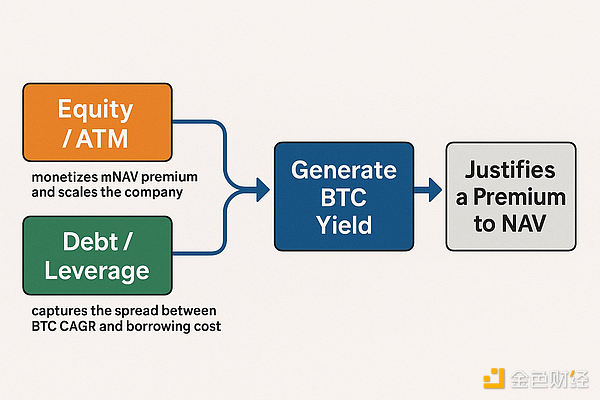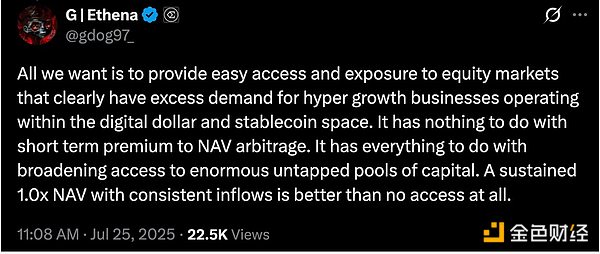Written by: Viktor
Translated by: Shaw Golden Finance
What is the goal of a Bitcoin treasury reserve company? It is to increase the ratio of Bitcoin per share, that is, the ratio between the total amount of Bitcoin held by the company and the number of shares fully diluted.
Microstrategy is not trying to time the market with Bitcoin trading to gain dollar profits; their sole focus is on increasing Bitcoin on their balance sheet in a value-added manner, thereby increasing the Bitcoin per share (BPS) ratio.
We refer to the scale of Bitcoin held as "Net Asset Value (NAV)," and the ratio of its market value to NAV is called "Market NAV Premium (mNAV)." If a company's market value is $10 billion and the value of its held Bitcoin is $5 billion, then the company's mNAV is 2. (Assuming the company has 100 million shares outstanding at $100 per share, and the Bitcoin price is $100,000. This means the company holds 50,000 Bitcoins, or 50000/100000 = 0.5 Bitcoins per 1000 shares.)
The primary way a Bitcoin reserve company enhances its earnings per share (BPS) is through an "ATM" (at-the-market) program: issuing new shares, selling them directly in the market, and using the proceeds to buy more Bitcoin. This is the first method that reserve companies can utilize.
Part One: Equity (ATM)
Returning to my example, this $10 billion market cap company can issue $1 billion worth of new shares, sell them in the market, and then immediately use the cash to purchase $1 billion worth of Bitcoin. Assuming the prices of stocks and Bitcoin remain unchanged (this is just to understand the underlying math), the company's new market value would be $11 billion, and the new NAV would be $6 billion. Its NAV premium is now 11/6 = 1.83, which has decreased, but its Bitcoin per share ratio is now 60000/110000 = 0.545, which has increased. We can then define a "Bitcoin Yield," which is the growth in earnings per share: 0.0545/0.5 = 1.09, or a 9% yield.
The company has acquired more Bitcoin in a "value-added" manner: even with the dilution of shares, this dilution is still value-added in terms of earnings per share because this ratio has increased.
This operation is the most commonly used method by Bitcoin treasury reserve companies and can only be conducted when the company's trading price is above its NAV, that is, when the mNAV premium is above 1. The higher the mNAV premium, the more profitable this ATM operation becomes, resulting in a higher "Bitcoin Yield."
Essentially, the company's management is selling shares to short-term stock buyers at a premium, and the proceeds they obtain will ultimately benefit long-term shareholders. (But obviously, short-term buyers may become long-term shareholders, so if they believe it is worthwhile in the long run, it is rational to accept buying at a larger premium.)
This "arbitrage" between the company's market value and its balance sheet can theoretically also be reversed: if the company's stock price is significantly discounted relative to its NAV, management can decide to sell Bitcoin from its balance sheet to repurchase shares, which would also increase the number of Bitcoins per share.
In both cases, management is trading with short-term stock traders who either buy at a significant premium or sell at a significant discount, and the profits from these operations will be redistributed to long-term shareholders, enhancing their book value per share, which means the theoretical "floor price" of the stock held in Bitcoin terms is rising.
In practice, the most attractive operation for the company so far has been to sell shares when the premium is above NAV (mNAV), as selling when mNAV is depreciating is trickier: first, if the scale is large enough (which it is in terms of strategy), it may negatively impact the price of the underlying asset (Bitcoin), potentially leading to a "death spiral" (where both Bitcoin and stock prices fall). Second, this sends negative signals to the market, making the company appear weaker and also reducing its scale. Finally, this operation may involve tax issues, thereby reducing its profitability.
Therefore, a Bitcoin reserve company primarily focuses on selling shares at a higher NAV to increase earnings per share and generate Bitcoin yields. It is worth noting that since shareholders buy into Bitcoin reserve companies for their Bitcoin yields, higher Bitcoin yields justify the rationale for purchasing such companies at a higher NAV, which will also enable the company to continue generating higher Bitcoin yields. A higher NAV per share is both a cause and an effect.
"This sounds unsustainable; it only works if there are more foolish people willing to buy at a premium!" Yes, that is generally correct, which is why a Bitcoin reserve company that operates solely by selling shares (ATM) is a flawed tool. Any aspiring Bitcoin reserve company should also utilize a second means to acquire Bitcoin yields: using debt above equity.
Part Two: Debt (Leverage)
The way companies use debt is very straightforward: if you believe Bitcoin will grow at a certain compound annual growth rate (CAGR) (i.e., annualized return), you can issue fixed-income instruments with an interest rate lower than that CAGR and "capture the spread" in the form of Bitcoin yields.
I won't detail what debt instruments a company might use, but let's assume it can borrow at an annual interest rate of 8% and expects Bitcoin's annual compound growth rate to exceed 20%. Then, the company can borrow dollars, use the proceeds to buy Bitcoin, thus obtaining a 12% spread (20%-8%), and then return the profits to shareholders through a higher earnings per share ratio.
Clearly, I know people are extremely afraid of leverage, often believing that using any leverage in the cryptocurrency space will lead to total loss, but: 1/ I wrote an entire article (soon to be updated) introducing Microstrategy, showing that their use of leverage is very conservative, with a very low likelihood of liquidation; 2/ Obviously, moderate use of leverage can outperform Bitcoin, especially when you have debt term protection.
A simple mental model can help understand the type of leverage involved in companies like Microstrategy, which is to imagine a long Bitcoin long position with 1.2x leverage that would only be forcibly liquidated if the Bitcoin price remained below the theoretical "liquidation price" for three consecutive years.
If a company can permanently acquire more Bitcoin through leverage, it will be able to maintain a reserve that outperforms Bitcoin, thus providing Bitcoin yields to shareholders. Long-term shareholders can view the Bitcoin value ratio per share as the theoretical floor of their stock price, and this floor will permanently rise in Bitcoin terms. A Bitcoin reserve company is essentially a tool designed to outperform Bitcoin performance. This is why some people are willing to hold these companies' stocks at prices above book value for the long term without becoming suckers.
For example, in 2024, Microstrategy (MSTR) generated 75% Bitcoin yield for its shareholders. This means that if your price floor per share was 0.001 Bitcoin at the beginning of 2024, it would become 0.00175 Bitcoin by the end of the year. If you bought MSTR at 1.75 times NAV at the beginning of 2024, then the entire 75% premium you paid above NAV would be recouped within just one year.

Since the market expects a company to provide Bitcoin yields to its shareholders in the future, it is entirely reasonable to buy the company's stock at a price above book value, and the notion of "exchanging $1 of Bitcoin for $3" is completely absurd.
What is the growth path of a full-stack crypto reserve company?
So, reviewing the content of the first two parts, a "full-stack Bitcoin reserve company" should have "two legs": the first leg is equity, and the second leg is debt. Typically, they start with equity and use ATM to kickstart the flywheel. By establishing a consistent record of regularly purchasing Bitcoin, the company builds trust as a Bitcoin reserve company strictly following Michael Saylor's strategy, which encourages investors to give it a higher premium, allowing the company to achieve good Bitcoin yields.
Using ATM helps to scale the company, and once a certain scale is reached, they can begin issuing fixed-income instruments, which proves they can "leverage" a higher NAV again, thereby further expanding their scale, repeating this process as long as conditions allow.

"How long will that last?" Well, as long as Bitcoin's compound annual growth rate significantly exceeds their debt interest payments, I think this situation can last a long time… Obviously, the main factor determining how quickly such a company can grow is how much its market value premium relative to NAV is, which is determined by the market, depending on attention, how reliable the company appears, how charismatic the CEO is, and so on.
Another general rule is that as the company grows, the mNAV (market NAV) should gradually decrease, but this does not mean that the premium will end at 1; a medium/long-term equilibrium mNAV could very well exceed 1.5. This also does not mean that buying into a small company with a very high premium is a bad choice, because if the Bitcoin yield it offers is high enough, this approach can also be justified. As I wrote earlier, each ATM operation reduces the mNAV premium, but this does not necessarily mean that your performance is inferior to the underlying asset (Bitcoin) during the same period. Theoretically, a company's mNAV could drop from 5 times to 2 times while both Bitcoin and stock prices remain unchanged during that time.
What about altcoin treasury reserve companies?
Since I have discussed Bitcoin treasury reserve companies, what about reserve companies for other coins? Well, they operate on the same underlying model. But there are clearly significant differences, as using other coins as the underlying asset means using a much weaker asset, and the possibility of "only going up" is much lower.
This means that using fixed-income portions is much riskier, and most companies may not choose this path. If your altcoin gradually falls back to zero over time (as most altcoins do), then borrowing dollars at an interest rate of 8% (or even 4%) to purchase altcoins is clearly a bad idea.
Perhaps the best framework for thinking about these treasury reserve companies is the one proposed by Guy Young (founder of Ethena) here:

Altcoin reserve companies are merely a tool that allows the public market (and its vast scale) to access altcoins in an imperfect manner. This is beneficial for stock buyers because even purchasing the underlying asset at a premium is better than not being able to buy it at all (if they are bullish), and it is also advantageous for altcoins as it brings in a new flow of funds compared to relying solely on crypto-native funding pools.
However, compared to Bitcoin reserve companies, altcoin reserve companies are still incomplete tools because they cannot utilize both equity and debt paths to generate Bitcoin/cryptocurrency yields. This means that the market NAV of these companies is more likely to trend towards 1, and they may even trade at a discount. But this is not the case for Bitcoin reserve companies.
As for Ethereum reserve companies, they can completely emulate Michael Saylor's strategy by utilizing fixed-income instruments. If you believe that Ethereum's long-term compound annual growth rate is similar to Bitcoin's, then this is indeed a good idea. However, if you do not have such strong confidence in Ethereum's future, then the risk of issuing debt to purchase Ethereum is much greater.
Summary
- A true "full-stack" treasury reserve system has two aspects:
- Phase One: Equity / ATM transforms the mNAV premium, which is a key tool for the company to achieve scale expansion.
- Phase Two: Debt monetizes the spread between Bitcoin's compound annual growth rate and the cost of borrowing.
- A premium for high-quality stocks with mNAV greater than 1 may be very reasonable:
If Bitcoin yield (BPS growth) ≥ the premium paid, long-term holders will still profit.
- Altcoin treasury reserves are singular, i.e., incomplete tools:
Without debt leverage, they should trend towards an mNAV of 1 (or lower) in the long run.
免责声明:本文章仅代表作者个人观点,不代表本平台的立场和观点。本文章仅供信息分享,不构成对任何人的任何投资建议。用户与作者之间的任何争议,与本平台无关。如网页中刊载的文章或图片涉及侵权,请提供相关的权利证明和身份证明发送邮件到support@aicoin.com,本平台相关工作人员将会进行核查。




